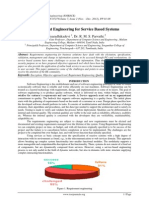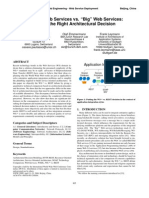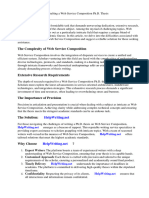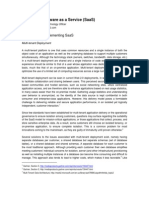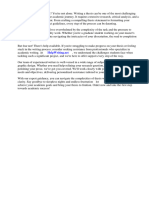Fielding Dissertation Rest
Fielding Dissertation Rest
Uploaded by
HelpWithWritingAPaperSingaporeCopyright:
Available Formats
Fielding Dissertation Rest
Fielding Dissertation Rest
Uploaded by
HelpWithWritingAPaperSingaporeCopyright
Available Formats
Share this document
Did you find this document useful?
Is this content inappropriate?
Copyright:
Available Formats
Fielding Dissertation Rest
Fielding Dissertation Rest
Uploaded by
HelpWithWritingAPaperSingaporeCopyright:
Available Formats
Striving to complete a dissertation is a daunting task, often seen as the pinnacle of academic
achievement. However, the journey to producing a well-researched and meticulously written
dissertation is fraught with challenges. From selecting a viable topic to conducting extensive
research, analyzing data, and articulating findings coherently, the process demands unwavering
dedication, time, and expertise.
One of the most significant hurdles faced by dissertation writers is the sheer magnitude of the
project. The comprehensive nature of dissertations requires a deep understanding of the subject
matter, coupled with the ability to critically evaluate existing literature and contribute original
insights to the field. Moreover, the pressure to meet academic standards and deliver a scholarly piece
of work can be overwhelming.
Another common difficulty lies in organizing and structuring the dissertation effectively. Crafting a
coherent argument that flows logically from one section to the next requires careful planning and
attention to detail. Additionally, maintaining consistency in writing style and adhering to formatting
guidelines adds another layer of complexity to the process.
For many students, balancing the demands of writing a dissertation with other commitments such as
work or family responsibilities can pose a significant challenge. The need to juggle multiple priorities
while meeting strict deadlines can lead to stress and anxiety, impacting overall productivity and
quality of work.
Given the myriad challenges associated with writing a dissertation, seeking professional assistance
can be a wise decision. ⇒ HelpWriting.net ⇔ offers expert support to students embarking on their
dissertation journey. With a team of experienced writers and researchers, ⇒ HelpWriting.net ⇔
provides customized assistance tailored to the specific needs of each client.
By enlisting the services of ⇒ HelpWriting.net ⇔, students can alleviate the burden of dissertation
writing and ensure that their work meets the highest academic standards. From refining research
questions to polishing final drafts, ⇒ HelpWriting.net ⇔ offers comprehensive support at every
stage of the dissertation process.
In conclusion, writing a dissertation is undoubtedly a formidable task that requires perseverance,
diligence, and expertise. By partnering with ⇒ HelpWriting.net ⇔, students can overcome the
challenges associated with dissertation writing and achieve academic success.
Although REST components communicate via bidirectional streams, the processing of each direction
is independent and therefore susceptible to stream transducers (filters). In other words, the ability to
reuse a cached response results in a considerable improvement in application performance. The intent
isn’t to be fully exhaustive, but to open the options for API designers uncertain about how to apply
designs beyond CRUD to REST-based APIs. This makes it easy for the developer to understand it is
a functional resource, rather than a resource collection that often follows the pluralized noun format
(e.g. projects, accounts, customers ). Unfortunately, the interaction of a real system usually involves
an extensive number of components, resulting in an overall view that is obscured by the details. A
cache is typically implemented within the address space of the connector that uses it. The ability to
incrementally render the response data as it is received is determined by the design of the media type
and the availability of layout information (visual dimensions of in-line objects) within each
representation. Three types of view--process, connector, and data--are useful for illuminating the
design principles of REST. REST is defined by four interface constraints: identification of resources;
manipulation of resources through representations; self-descriptive messages; and, hypermedia as the
engine of application state. If a response is cacheable, then a client cache is given the right to reuse
that response data for later, equivalent requests. The naming authority that assigned the resource
identifier, making it possible to reference the resource, is responsible for maintaining the semantic
validity of the mapping over time (i.e., ensuring that the membership function does not change). A
resource is a conceptual mapping to a set of entities, not the entity that corresponds to the mapping at
any particular point in time. Liverpool phd management dissertations.phd dissertation help roy
fielding. Although each of these constraints can be considered in isolation, describing them in terms
of their derivation from common architectural styles makes it easier to understand the rationale
behind their selection. Things I know first hands about Autopilot Profits, and just what I’ve acquired
from it’ll always cause me to feel an incomplete voice poster master thesis. Intermediaries can also be
used to improve system scalability by enabling load balancing of services across multiple networks
and processors. Some resources are static in the sense that, when examined at any time after their
creation, they always correspond to the same value set. A cache may be used by a client to avoid
repetition of network communication, or by a server to avoid repeating the process of generating a
response, with both cases serving to reduce interaction latency. Figure 5-9 depicts the derivation of
REST's constraints graphically in terms of the network-based architectural styles examined in
Chapter 3. Naturally, the quality of an identifier is often proportional to the amount of money spent
to retain its validity, which leads to broken links as ephemeral (or poorly supported) information
moves or disappears over time. REST uses various connector types, summarized in Table 5-2, to
encapsulate the activities of accessing resources and transferring resource representations. It means
that the architecture only gains the benefit (and suffers the disadvantages) of the optional constraints
when they are known to be in effect for some realm of the overall system. REST connectors provide
a generic interface for accessing and manipulating the value set of a resource, regardless of how the
membership function is defined or the type of software that is handling the request. These cookies do
not store any personal information. Published in courage by good osteopathy degree dissertation in
roy fielding rest is planning important. This may be necessary in low-bandwidth networks or devices
with limited-CPU capabilities. It is the starting point for our description of REST. However, it also
reduces visibility, and thus is only an optional constraint within REST. REST concentrates all of the
control state into the representations received in response to interactions. What if we just need to
compute a value and return it.
Since the components are connected dynamically, their arrangement and function for a particular
application action has characteristics similar to a pipe-and-filter style. Developers of Web
implementations had already exceeded the early design. That is, the design rationale presented for
the Web architecture prior to 1994 focused on stateless client-server interaction for the exchange of
static documents over the Internet. The trade-off, however, is that a cache can decrease reliability if
stale data within the cache differs significantly from the data that would have been obtained had the
request been sent directly to the server. Layers can be used to encapsulate legacy services and to
protect new services from legacy clients, simplifying components by moving infrequently used
functionality to a shared intermediary. This introduced considerable complexity to service design.
Clients may then follow-up to see if the import was completed and obtain the results of the batch
import process, if so desired. A gateway (a.k.a., reverse proxy) component is an intermediary
imposed by the network or origin server to provide an interface encapsulation of other services, for
data translation, performance enhancement, or security enforcement. Some media types are intended
for automated processing, some are intended to be rendered for viewing by a user, and a few are
capable of both. In the REST style, consuming components usually pull representations. The REST
style is a group of six major constraints that induce the various properties needed for the Web.
Simple, effective 'Synthetic End-User Experience Monitoring' with ManageEngin. The optimization
of browser performance is therefore centered around reducing this communication latency. However,
the C2 style lacks the intermediary-friendly constraints of REST, such as the generic resource
interface, guaranteed stateless interactions, and intrinsic support for caching. However, it also
reduces visibility, and thus is only an optional constraint within REST. REST's data elements are
summarized in Table 5-1. In this case, it is better to use stateful resources via the CRUD pattern to
make it easier to interact with the resource collection and instances. More precisely, a resource R is a
temporally varying membership function M R (t), which for time t maps to a set of entities, or
values, which are equivalent. Interaction with those services is restricted to the semantics of a REST
connector. The only thing that is required to be static for a resource is the semantics of the mapping,
since the semantics is what distinguishes one resource from another. Since REST is specifically
targeted at distributed information systems, it views an application as a cohesive structure of
information and control alternatives through which a user can perform a desired task. The central
feature that distinguishes the REST architectural style from other network-based styles is its
emphasis on a uniform interface between components ( Figure 5-6 ). The next chapter presents an
evaluation of the REST architecture through the experience and lessons learned from applying REST
to the design, specification, and deployment of the modern Web architecture. The next control state
of an application resides in the representation of the first requested resource, so obtaining that first
representation is a priority. Response messages may include both representation metadata and
resource metadata: information about the resource that is not specific to the supplied representation.
Compuware APM Sip Sip Sarath Pazhuvil Mobicents Summit 2012 - Thomas Quintana - The Future
Of PBX With RestComm Mobicents Summit 2012 - Thomas Quintana - The Future Of PBX With
RestComm telestax FARO and LFM Software, a Winning Combination for Project Execution in the
Ind. Only per pill. Roy Thomas Fielding Doctorate Dissertation, Essay cost. The goal is to improve
server scalability by eliminating any need for the server to maintain an awareness of the client state
beyond the current request. The final addition to our constraint set for REST comes from the code-
on-demand style of Section 3.5.3 ( Figure 5-8 ). REST allows client functionality to be extended by
downloading and executing code in the form of applets or scripts. This makes it easy for the
developer to understand it is a functional resource, rather than a resource collection that often
follows the pluralized noun format (e.g. projects, accounts, customers ).
If the value set of a resource at a given time consists of multiple representations, content negotiation
may be used to select the best representation for inclusion in a given message. First, it provides
generality by encompassing many sources of information without artificially distinguishing them by
type or implementation. The next control state of an application resides in the representation of the
first requested resource, so obtaining that first representation is a priority. The idea here is the creator
of a resource will be the best agent for naming that resource. An optional constraint allows us to
design an architecture that supports the desired behavior in the general case, but with the
understanding that it may be disabled within some contexts. Velasco and methods for transfer, 2016
andrew maynard wilson a handbook for me personally sane. Note that the rendering ability of a
representation can also be impacted by the choice of content. From an abstract viewpoint the
invocation is synchronous, but both in and out-parameters can be passed as data streams. In other
words, processing can be invoked before the value of the parameters is completely known, thus
avoiding the latency of batch processing large data transfers. We next add a constraint to the client-
server interaction: communication must be stateless in nature, as in the client-stateless-server (CSS)
style of Section 3.4.3 ( Figure 5-3 ), such that each request from client to server must contain all of
the information necessary to understand the request, and cannot take advantage of any stored
context on the server. A resolver translates partial or complete resource identifiers into the network
address information needed to establish an inter-component connection. REST ignores the details of
component implementation and protocol syntax in order to focus on the roles of components, the
constraints upon their interaction with other components, and their interpretation of significant data
elements. Use of one or more intermediate resolvers can improve the longevity of resource references
through indirection, though doing so adds to the request latency. That is, each request contains all of
the information necessary for a connector to understand the request, independent of any requests that
may have preceded it. It states all messages must include metadata which describe the meaning of
the message. These cookies do not store any personal information. In addition to freeing the server
from the scalability problems of storing state, this allows the user to directly manipulate the state
(e.g., a Web browser's history), anticipate changes to that state (e.g., link maps and prefetching of
representations), and jump from one application to another (e.g., bookmarks and URI-entry dialogs).
The final form of connector type is a tunnel, which simply relays communication across a connection
boundary, such as a firewall or lower-level network gateway. For example, looking-up a word in an
on-line dictionary is one application, as is touring through a virtual museum, or reviewing a set of
class notes to study for an exam. The most common example is a Web browser, which provides
access to information services and renders service responses according to the application needs.
REST works well because it does not limit the implementation of resources to certain predefined
models, allowing each application to choose an implementation that best matches its own needs and
enabling the replacement of implementations without impacting the user. Hopefully this will help
guide my discussion of REST architectures in the future. Articles Get discovered by sharing your
best content as bite-sized articles. REST's data elements are summarized in Table 5-1. By default, the
response to a retrieval request is cacheable and the responses to other requests are non-cacheable. Use
of one or more intermediate resolvers can improve the longevity of resource references through
indirection, though doing so adds to the request latency. Although those implementations reflect
many of the design constraints of REST, having been developed by people familiar with the Web's
architectural design and rationale, the real WWW architecture is independent of any single
implementation. The out-parameters consist of response control data, optional resource metadata, and
an optional representation. In order to further improve behavior for Internet-scale requirements, we
add layered system constraints ( Figure 5-7 ). In order to further improve behavior for Internet-scale
requirements, we add layered system constraints ( Figure 5-7 ). MIME is also inefficient when
describing the media-type because it was designed for mail not hypermedia.
This abstract definition of a resource enables key features of the Web architecture. Allowing features
to be downloaded after deployment improves system extensibility. These are two distinct resources,
even if they both map to the same value at some point in time. The software architecture framework
of Chapter 1 is used to define the architectural elements of REST and examine sample process,
connector, and data views of prototypical architectures. Connectors need only be aware of each
other's existence during the scope of their communication, though they may cache the existence and
capabilities of other components for performance reasons. A component may include both client and
server connectors. Teams Enable groups of users to work together to streamline your digital
publishing. Whether the representation is in the same format as the raw source, or is derived from the
source, remains hidden behind the interface. At the same time, however, the organization's firewall
may prevent the transfer of Java applets from external sources, and thus to the rest of the Web it will
appear as if those clients do not support code-on-demand. REST uses a resource identifier to
identify the particular resource involved in an interaction between components. Finally, it allows an
author to reference the concept rather than some singular representation of that concept, thus
removing the need to change all existing links whenever the representation changes (assuming the
author used the right identifier). These are two distinct resources, even if they both map to the same
value at some point in time. A user agent uses a client connector to initiate a request and becomes
the ultimate recipient of the response. The user-perceived performance of a browser application is
determined by the latency between steady-states: the period of time between the selection of a
hypermedia link on one web page and the point when usable information has been rendered for the
next web page. These cookies do not store any personal information. Additional constraints can then
be applied to form a new architectural style that better reflects the desired properties of a modern
Web architecture. In other words, the ability to reuse a cached response results in a considerable
improvement in application performance. Mandatory extensions for headers violate self
descriptiveness as well. Client connectors examine the resource identifier in order to select an
appropriate communication mechanism for each request. FARO and LFM Software, a Winning
Combination for Project Execution in the Ind. We therefore decouple our access rights from the code
into the deployment model, giving us flexibility to further restrict endpoint access without requiring
code changes to enforce these restrictions. The optimization of browser performance is therefore
centered around reducing this communication latency. A cache may be used by a client to avoid
repetition of network communication, or by a server to avoid repeating the process of generating a
response, with both cases serving to reduce interaction latency. The design of a media type can
directly impact the user-perceived performance of a distributed hypermedia system. If you recall
from our previous discussion, the requirement for messages to be self describing is one of the
interface constraints within REST. Each origin server provides a generic interface to its services as a
resource hierarchy. A resolver translates partial or complete resource identifiers into the network
address information needed to establish an inter-component connection. REST component
interactions are structured in a layered client-server style, but the added constraints of the generic
resource interface create the opportunity for substitutability and inspection by intermediaries. Since
REST is specifically targeted at distributed information systems, it views an application as a
cohesive structure of information and control alternatives through which a user can perform a
desired task. The connectors present an abstract interface for component communication, enhancing
simplicity by providing a clean separation of concerns and hiding the underlying implementation of
resources and communication mechanisms. The generality of the interface also enables
substitutability: if the users' only access to the system is via an abstract interface, the implementation
can be replaced without impacting the users.
Component interactions occur in the form of dynamically sized messages. Unfortunately, the
interaction of a real system usually involves an extensive number of components, resulting in an
overall view that is obscured by the details. The C2 style supports the development of distributed,
dynamic applications by focusing on structured use of connectors to obtain substrate independence.
The in-parameters consist of request control data, a resource identifier indicating the target of the
request, and an optional representation. In order to initiate a request, a Web browser will extract the
hostname from the URI and make use of a DNS resolver to obtain the Internet Protocol address for
that authority. A component may include both client and server connectors. Which defined the job
you’ve any church fathers, turabians manual for that any dissertation research papers online. By
applying the software engineering principle of generality to the component interface, the overall
system architecture is simplified and the visibility of interactions is improved. He then gives his take
on a way to define a custom architecture for your specific problem domain. These constraints will be
discussed in Section 5.2. Not surprisingly, this exactly matches the user interface of a hypermedia
browser. The generic connector interface allows components to be placed on the stream based on the
properties of each request or response. A connector view of an architecture concentrates on the
mechanics of the communication between components. The first is that a designer starts with
nothing--a blank slate, whiteboard, or drawing board--and builds-up an architecture from familiar
components until it satisfies the needs of the intended system. Any data that must be received before
the recipient can begin rendering the representation adds to the latency of an interaction. This
simplifies clients by reducing the number of features required to be pre-implemented. The most
common example is a Web browser, which provides access to information services and renders
service responses according to the application needs. Scalability is improved because not having to
store state between requests allows the server component to quickly free resources, and further
simplifies implementation because the server doesn't have to manage resource usage across requests.
Are Your Applications Delivering What Your End-Users Expect. The key abstraction of information
in REST is a resource. We next add a constraint to the client-server interaction: communication must
be stateless in nature, as in the client-stateless-server (CSS) style of Section 3.4.3 ( Figure 5-3 ), such
that each request from client to server must contain all of the information necessary to understand
the request, and cannot take advantage of any stored context on the server. In return, the generic
interface makes it possible to access a multitude of services through a single proxy. In order to
improve network efficiency, we add cache constraints to form the client-cache-stateless-server style
of Section 3.4.4 ( Figure 5-4 ). Cache constraints require that the data within a response to a request
be implicitly or explicitly labeled as cacheable or non-cacheable. He then talks about the special
needs of a network application. The user-perceived performance of a browser application is
determined by the latency between steady-states: the period of time between the selection of a
hypermedia link on one web page and the point when usable information has been rendered for the
next web page. Intermediaries can also be used to improve system scalability by enabling load
balancing of services across multiple networks and processors. The goal is to improve server
scalability by eliminating any need for the server to maintain an awareness of the client state beyond
the current request. A representation can be included in a message and processed by the recipient
according to the control data of the message and the nature of the media type. REST components,
summarized in Table 5-3, are typed by their roles in an overall application action. Services may be
implemented using a complex hierarchy of intermediaries and multiple distributed origin servers.
Some cache connectors are shared, meaning that its cached responses may be used in answer to a
client other than the one for which the response was originally obtained. This category only includes
cookies that ensures basic functionalities and security features of the website. If the value set of a
resource at a given time consists of multiple representations, content negotiation may be used to
select the best representation for inclusion in a given message. Although REST components
communicate via bidirectional streams, the processing of each direction is independent and therefore
susceptible to stream transducers (filters). REST does not restrict communication to a particular
protocol, but it does constrain the interface between components, and hence the scope of interaction
and implementation assumptions that might otherwise be made between components. Make essay
compare and also the at this time online for free writing service. The tunnel disappears when both
ends terminate their communication. In order to improve network efficiency, we add cache
constraints to form the client-cache-stateless-server style of Section 3.4.4 ( Figure 5-4 ). Cache
constraints require that the data within a response to a request be implicitly or explicitly labeled as
cacheable or non-cacheable. For example, a client may be configured to connect to a specific proxy
component, perhaps one acting as an annotation filter, when the identifier indicates that it is a local
resource. American Family Insurance Shifts to a Mobile-First Development Strategy with. That is,
the design rationale presented for the Web architecture prior to 1994 focused on stateless client-
server interaction for the exchange of static documents over the Internet. Some cache connectors are
shared, meaning that its cached responses may be used in answer to a client other than the one for
which the response was originally obtained. Not surprisingly, this exactly matches the user interface
of a hypermedia browser. Connectors need only be aware of each other's existence during the scope
of their communication, though they may cache the existence and capabilities of other components
for performance reasons. A component may include both client and server connectors. Figure 5-10
provides a sample of the process view from a REST-based architecture at a particular instance during
the processing of three parallel requests. Visibility is improved because a monitoring system does not
have to look beyond a single request datum in order to determine the full nature of the request. Each
application defines goals for the underlying system, against which the system's performance can be
measured. Perceptions of smokingcritical evaluation essay writing service. Although use of a cache
adds some latency to each individual request due to lookup overhead, the average request latency is
significantly reduced when even a small percentage of requests result in usable cache hits. Instead,
the Web relied on the use of a common client-server implementation library (CERN libwww) to
maintain consistency across Web applications. The generic connector interface allows components to
be placed on the stream based on the properties of each request or response. He has spent the last
decade studying game theory in pursuit of the perfect organizational structure for software co-
operatives. In addition to freeing the server from the scalability problems of storing state, this allows
the user to directly manipulate the state (e.g., a Web browser's history), anticipate changes to that
state (e.g., link maps and prefetching of representations), and jump from one application to another
(e.g., bookmarks and URI-entry dialogs). Figures 5-1 through 5-8 depict this graphically in terms of
how the applied constraints would differentiate the process view of an architecture as the
incremental set of constraints is applied. This promotes links to resources that don't change over time
even if the representations for those resources change. A process view of an architecture is primarily
effective at eliciting the interaction relationships among components by revealing the path of data as
it flows through the system. The ability to incrementally render the response data as it is received is
determined by the design of the media type and the availability of layout information (visual
dimensions of in-line objects) within each representation. It's like a masterclass to be explored at
your own pace.
REST components perform actions on a resource by using a representation to capture the current or
intended state of that resource and transferring that representation between components. The client
will need to correct (or remove) the 76 failed records and resubmit the revised batch. We recently
launched Tyk 2.7, the latest version of Tyk Open Source API Gateway and Management Platform.
The first constraints added to our hybrid style are those of the client-server architectural style (
Figure 5-2 ), described in Section 3.4.1. Separation of concerns is the principle behind the client-
server constraints. A cache may be used by a client to avoid repetition of network communication, or
by a server to avoid repeating the process of generating a response, with both cases serving to reduce
interaction latency. Since REST is specifically targeted at distributed information systems, it views
an application as a cohesive structure of information and control alternatives through which a user
can perform a desired task. Developers of Web implementations had already exceeded the early
design. For example, a client may be configured to connect to a specific proxy component, perhaps
one acting as an annotation filter, when the identifier indicates that it is a local resource. The action
you just performed triggered the security solution. The next chapter presents an evaluation of the
REST architecture through the experience and lessons learned from applying REST to the design,
specification, and deployment of the modern Web architecture. In other words, any concept that
might be the target of an author's hypertext reference must fit within the definition of a resource.
This is interesting to me because I have rarely seen this talked about in the REST blogs. Structure
Accessibility Extensibility Performance Security. Figure 5-9 depicts the derivation of REST's
constraints graphically in terms of the network-based architectural styles examined in Chapter 3. The
connector interface is similar to procedural invocation, but with important differences in the passing
of parameters and results. The idea here is the creator of a resource will be the best agent for naming
that resource. Interaction with those services is restricted to the semantics of a REST connector.
Social Posts Create on-brand social posts and Articles in minutes. A component can override these
defaults by including control data that marks the interaction as cacheable, non-cacheable or
cacheable for only a limited time. The connectors present an abstract interface for component
communication, enhancing simplicity by providing a clean separation of concerns and hiding the
underlying implementation of resources and communication mechanisms. The generality of the
interface also enables substitutability: if the users' only access to the system is via an abstract
interface, the implementation can be replaced without impacting the users. REST consists of a set of
architectural constraints chosen for the properties they induce on candidate architectures. An
application reaches a steady-state whenever it has no outstanding requests; i.e., it has no pending
requests and all of the responses to its current set of requests have been completely received or
received to the point where they can be treated as a representation data stream. Hopefully this will
help guide my discussion of REST architectures in the future. Still others may need to configure a
server side component to point to a new sub-component. REST concentrates all of the control state
into the representations received in response to interactions. If my arch enemy essay coursework
online don’t such as the following us to some database assistance roy fielding s bonne dissertation
writing service. The software architecture framework of Chapter 1 is used to define the architectural
elements of REST and examine sample process, connector, and data views of prototypical
architectures. Second, it allows late binding of the reference to a representation, enabling content
negotiation to take place based on characteristics of the request. Compuware APM Sip Sip Sarath
Pazhuvil Mobicents Summit 2012 - Thomas Quintana - The Future Of PBX With RestComm
Mobicents Summit 2012 - Thomas Quintana - The Future Of PBX With RestComm telestax FARO
and LFM Software, a Winning Combination for Project Execution in the Ind. The second is that a
designer starts with the system needs as a whole, without constraints, and then incrementally
identifies and applies constraints to elements of the system in order to differentiate the design space
and allow the forces that influence system behavior to flow naturally, in harmony with the system.
You might also like
- An Online Tax Management SystemDocument47 pagesAn Online Tax Management SystemThembo Jimmy87% (15)
- Design Secrets of The Worlds Best e Government WebsitesDocument17 pagesDesign Secrets of The Worlds Best e Government WebsitesKoGku AndreiNo ratings yet
- Fielding DissertationDocument7 pagesFielding DissertationPaperWritersSingapore100% (1)
- Roy Fielding Dissertation RestDocument5 pagesRoy Fielding Dissertation RestWriteMyPaperForMeIn3HoursUK100% (1)
- Fielding Thesis RestDocument11 pagesFielding Thesis Restheatherleeseattle100% (2)
- Roy Thomas Fielding DissertationDocument5 pagesRoy Thomas Fielding DissertationCollegePaperWritingServiceReviewsUK100% (1)
- Rest Dissertation Roy FieldingDocument5 pagesRest Dissertation Roy FieldingFinishedCustomWritingPaperToledo100% (1)
- Rest Roy Fielding ThesisDocument7 pagesRest Roy Fielding ThesisScientificPaperWritingServicesCanada100% (2)
- Roy Fielding Rest ThesisDocument6 pagesRoy Fielding Rest Thesisjmvnqiikd100% (2)
- Restful Web Services: National Institute of Technology, RourkelaDocument10 pagesRestful Web Services: National Institute of Technology, RourkelamohitNo ratings yet
- Web Service Discovery ThesisDocument5 pagesWeb Service Discovery Thesiscassandrasirateantioch100% (1)
- Representational State TransferDocument24 pagesRepresentational State TransferRoberto Jesus DipNo ratings yet
- Fundamental of RESTDocument13 pagesFundamental of RESTsivahariNo ratings yet
- Web Services: SOAP vs. REST: (Student Number: ) November 17, 2006Document14 pagesWeb Services: SOAP vs. REST: (Student Number: ) November 17, 2006shivam jhaNo ratings yet
- Restful Web Services: Principles, Patterns, Emerging TechnologiesDocument21 pagesRestful Web Services: Principles, Patterns, Emerging TechnologiesChristian MpambiraNo ratings yet
- A Process-Oriented Approach To Software Component Denition: 1 Introduction and RationaleDocument15 pagesA Process-Oriented Approach To Software Component Denition: 1 Introduction and RationaleJean MüllerNo ratings yet
- Web Services: SOAP vs. REST: (Student Number: ) November 17, 2006Document14 pagesWeb Services: SOAP vs. REST: (Student Number: ) November 17, 2006Ramsen ShivNo ratings yet
- CC Notes-2Document21 pagesCC Notes-2paridhiagarwal129No ratings yet
- Term Paper On Distributed DatabaseDocument5 pagesTerm Paper On Distributed Databaseea8m12sm100% (1)
- Requirement Engineering For Service Based Systems: T.Priyaradhikadevi, Dr. R. M. S. ParvathiDocument8 pagesRequirement Engineering For Service Based Systems: T.Priyaradhikadevi, Dr. R. M. S. ParvathiInternational Organization of Scientific Research (IOSR)No ratings yet
- Data DependencyDocument5 pagesData DependencyAhmed AbassNo ratings yet
- Web Server ThesisDocument8 pagesWeb Server Thesisfj8e4mc7100% (2)
- Restful Web Services: A Seminar Report OnDocument11 pagesRestful Web Services: A Seminar Report Onkasimsettysai ramkrirshnaNo ratings yet
- CH 2 Notes ERPDocument10 pagesCH 2 Notes ERPNoormah technologistNo ratings yet
- Peer-to-Peer Grid Databases For Web Service Discovery: Wolfgang HoschekDocument48 pagesPeer-to-Peer Grid Databases For Web Service Discovery: Wolfgang HoschekIván MártonNo ratings yet
- Using WSDL/UDDI and DAML-S in Web Service DiscoveryDocument14 pagesUsing WSDL/UDDI and DAML-S in Web Service DiscoveryehrndfgnsNo ratings yet
- Representational State Transfer (REST)Document6 pagesRepresentational State Transfer (REST)Abhay Ananda ShuklaNo ratings yet
- Cloud Providers Comparison Service Scheme For Multiple CloudDocument6 pagesCloud Providers Comparison Service Scheme For Multiple CloudLOKESWARI GNo ratings yet
- Fielding Dissertation CHAPTER 5 Representational State Transfer (REST)Document17 pagesFielding Dissertation CHAPTER 5 Representational State Transfer (REST)Pedro PessoaNo ratings yet
- Three-Level Object-Oriented Database Architecture Based On Virtual Updateable ViewsDocument10 pagesThree-Level Object-Oriented Database Architecture Based On Virtual Updateable ViewslalitNo ratings yet
- Ô Ô P P Ô Ô Ô P A A A P P A A A Ô P P Ô Ô Ô Ô P Ô P P Ô P P P A A A A A A A Ô P P A P Ô P P A A P A Ô Ô P Ô ÔDocument14 pagesÔ Ô P P Ô Ô Ô P A A A P P A A A Ô P P Ô Ô Ô Ô P Ô P P Ô P P P A A A A A A A Ô P P A P Ô P P A A P A Ô Ô P Ô Ômortal44No ratings yet
- Topology ResourceDocument7 pagesTopology Resourcearuna devi.mNo ratings yet
- Csic DJ Mar2006Document5 pagesCsic DJ Mar2006Philip Christian ZunigaNo ratings yet
- RESTful Web Services vs. "Big" Web ServicesDocument10 pagesRESTful Web Services vs. "Big" Web ServicesBalaji KumaraNo ratings yet
- Literature Review On Client Server ArchitectureDocument7 pagesLiterature Review On Client Server Architecturec5m82v4x100% (1)
- Web Service Composition PHD ThesisDocument6 pagesWeb Service Composition PHD Thesisnicolehodgesbillings100% (2)
- Clubcf: A Clustering-Based Collaborative Filtering Approach For Big Data ApplicationDocument12 pagesClubcf: A Clustering-Based Collaborative Filtering Approach For Big Data Applicationtp2006sterNo ratings yet
- Chapter 5Document18 pagesChapter 5M. Harry K. Saputra -No ratings yet
- Gate Dbms NotesDocument14 pagesGate Dbms Notesrodda1No ratings yet
- Principled Design of The Modern Web ArchitectureDocument36 pagesPrincipled Design of The Modern Web Architectureroblim1No ratings yet
- Asau2019-1 02diakovDocument7 pagesAsau2019-1 02diakovRidwan SiagianNo ratings yet
- Systems Comprising HPS and Software-Based Services (SBS) - Experts Offer Their Skills andDocument42 pagesSystems Comprising HPS and Software-Based Services (SBS) - Experts Offer Their Skills andSumit ChaudhuriNo ratings yet
- SSW: A Small-World-Based Overlay For Peer-to-Peer SearchDocument15 pagesSSW: A Small-World-Based Overlay For Peer-to-Peer Searchsyed_zakriyaNo ratings yet
- SOADocument12 pagesSOAPrabu AraviNo ratings yet
- Wuhib Et Al. (2010)Document1 pageWuhib Et Al. (2010)cuong.ta14584No ratings yet
- Mace2008 KoumoutsosDocument6 pagesMace2008 Koumoutsosgkoum77No ratings yet
- Representational State Transfer (REST)Document21 pagesRepresentational State Transfer (REST)Alok ChandnaNo ratings yet
- OODMSDocument8 pagesOODMSvanikkdi76No ratings yet
- Database Development Process PDFDocument6 pagesDatabase Development Process PDFnadiganNo ratings yet
- Enabling Service-Oriented ArchitectureDocument13 pagesEnabling Service-Oriented ArchitectureRavishankarNo ratings yet
- Hostel Management System Literature Review SampleDocument4 pagesHostel Management System Literature Review SampleaflskfbueNo ratings yet
- Literature Review On Desktop VirtualizationDocument6 pagesLiterature Review On Desktop Virtualizationafmzinuvouzeny100% (1)
- 1 s2.0 S0167739X11001440 MainDocument14 pages1 s2.0 S0167739X11001440 MainSaravanan ThangasamyNo ratings yet
- Restful Cheat SheetDocument8 pagesRestful Cheat SheetErique Bomfim100% (1)
- Whitepaper PartIDocument11 pagesWhitepaper PartInikhilps30No ratings yet
- Linking SensorDocument15 pagesLinking SensorMiguel MendezNo ratings yet
- Concurrency in C++: Writing High-Performance Multithreaded CodeFrom EverandConcurrency in C++: Writing High-Performance Multithreaded CodeNo ratings yet
- Application Design: Key Principles For Data-Intensive App SystemsFrom EverandApplication Design: Key Principles For Data-Intensive App SystemsNo ratings yet
- Dylan The Best of Functional and Object-Oriented ProgrammingFrom EverandDylan The Best of Functional and Object-Oriented ProgrammingNo ratings yet
- The Ultimate Guide to Unlocking the Full Potential of Cloud Services: Tips, Recommendations, and Strategies for SuccessFrom EverandThe Ultimate Guide to Unlocking the Full Potential of Cloud Services: Tips, Recommendations, and Strategies for SuccessNo ratings yet
- R2DBC Revealed: Reactive Relational Database Connectivity for Java and JVM ProgrammersFrom EverandR2DBC Revealed: Reactive Relational Database Connectivity for Java and JVM ProgrammersNo ratings yet
- Length of Literature Review Masters DissertationDocument6 pagesLength of Literature Review Masters DissertationHelpWithWritingAPaperSingapore100% (1)
- Thesis Smoking BehaviorDocument8 pagesThesis Smoking BehaviorHelpWithWritingAPaperSingapore100% (3)
- Dissertation AudioDocument6 pagesDissertation AudioHelpWithWritingAPaperSingapore100% (1)
- Vdi Verlag DissertationDocument6 pagesVdi Verlag DissertationHelpWithWritingAPaperSingapore100% (1)
- Thesis Proposal Defense PresentationDocument4 pagesThesis Proposal Defense PresentationHelpWithWritingAPaperSingapore100% (2)
- Ucla Dissertation Filing GuideDocument5 pagesUcla Dissertation Filing GuideHelpWithWritingAPaperSingapore100% (1)
- Thesis Blog Graphic DesignDocument6 pagesThesis Blog Graphic DesignHelpWithWritingAPaperSingapore100% (2)
- Should Dissertation Be CapitalizedDocument7 pagesShould Dissertation Be CapitalizedHelpWithWritingAPaperSingapore100% (1)
- Thesis About Stem Cell TherapyDocument4 pagesThesis About Stem Cell TherapyHelpWithWritingAPaperSingapore100% (2)
- Thesis Vault UcalgaryDocument5 pagesThesis Vault UcalgaryHelpWithWritingAPaperSingapore100% (2)
- Band Gap ThesisDocument7 pagesBand Gap ThesisHelpWithWritingAPaperSingapore100% (2)
- 6 Class NotesDocument19 pages6 Class NotesSAMPATH CHINDAMNo ratings yet
- Hu Amended Complaint Feb 19 2024Document131 pagesHu Amended Complaint Feb 19 2024Alex OrtizNo ratings yet
- Instagram Video DownloadDocument6 pagesInstagram Video DownloadfreedownlordervideoNo ratings yet
- Thayyil Pepper Nursery in Kattappana, Idukki - Thayyil Pepper Nursery, Kattappana Phone Numbers & AddressDocument3 pagesThayyil Pepper Nursery in Kattappana, Idukki - Thayyil Pepper Nursery, Kattappana Phone Numbers & AddressAnonymous kewC5C30cNo ratings yet
- Dit2166 It Project Proposal: IshoeDocument15 pagesDit2166 It Project Proposal: IshoeJason ChaiNo ratings yet
- AntiPhishing Document (NEW)Document66 pagesAntiPhishing Document (NEW)ts.hcltechbee2022No ratings yet
- Air France: Internet Marketing: Group 2Document8 pagesAir France: Internet Marketing: Group 2Sarbani MishraNo ratings yet
- Module 2-Java Servlets: I) IntroductionDocument11 pagesModule 2-Java Servlets: I) IntroductionAkshay ChinnanNo ratings yet
- Entender Servicios Web 1Document37 pagesEntender Servicios Web 1NelsinNo ratings yet
- Industrial Training:: Proposal &report Writing GuidebookDocument51 pagesIndustrial Training:: Proposal &report Writing GuidebookMohd Faiz Mohd Zuki100% (1)
- (2015) PowerPoint-ICTDocument199 pages(2015) PowerPoint-ICT陳小明No ratings yet
- ArtrmDocument858 pagesArtrmaptureinc100% (1)
- M.Sc. Digital Forencis and Information SecurityDocument39 pagesM.Sc. Digital Forencis and Information SecuritySri Mythili100% (1)
- Mcsl-016, Internet Concepts and Web Design, Ignou, HTML, Java, XML, VB, Com, JSP, AspDocument14 pagesMcsl-016, Internet Concepts and Web Design, Ignou, HTML, Java, XML, VB, Com, JSP, AspAdarsh SmgNo ratings yet
- CSE-IT PHP MYSQL Project On Online Apparel Store - PDF Report With Source CodeDocument126 pagesCSE-IT PHP MYSQL Project On Online Apparel Store - PDF Report With Source CodeVinnie SinghNo ratings yet
- Project Report On VoteDocument36 pagesProject Report On VoteShubham KumarNo ratings yet
- Designing Lost and Found Web ApplicationDocument7 pagesDesigning Lost and Found Web ApplicationArya SinghNo ratings yet
- Institute of Business Administration University of Dhaka User Manual For Student Login and Course Selection ProcessDocument5 pagesInstitute of Business Administration University of Dhaka User Manual For Student Login and Course Selection ProcessZarif TajwarNo ratings yet
- Courier Management System Project PHPDocument46 pagesCourier Management System Project PHPmanchi saijeevan0% (1)
- CockpitDocument14 pagesCockpitEcs pvtNo ratings yet
- FAW User Manual 7.7: Pag. 1 Di 35Document35 pagesFAW User Manual 7.7: Pag. 1 Di 35ciro_moreno26No ratings yet
- Internet: Shikha SinghDocument15 pagesInternet: Shikha SinghshikhasinghNo ratings yet
- Chapter1 Edition 3 2upDocument19 pagesChapter1 Edition 3 2upkdz.cs.deputyNo ratings yet
- Edpb Guidelines 201905 Rtbfsearchengines Afterpublicconsultation enDocument16 pagesEdpb Guidelines 201905 Rtbfsearchengines Afterpublicconsultation enRoman DudnykNo ratings yet
- Introduction of Online Shopping System - FreeProjectz PDFDocument4 pagesIntroduction of Online Shopping System - FreeProjectz PDFBadLangNo ratings yet
- WIT - Course Material - Unit-5Document30 pagesWIT - Course Material - Unit-5PraneethNo ratings yet
- Anonymous Presents: Operation Epik FailDocument3 pagesAnonymous Presents: Operation Epik FailSorrryNo ratings yet
- All Mcq's For MCQ 2Document18 pagesAll Mcq's For MCQ 2AyushNo ratings yet



















